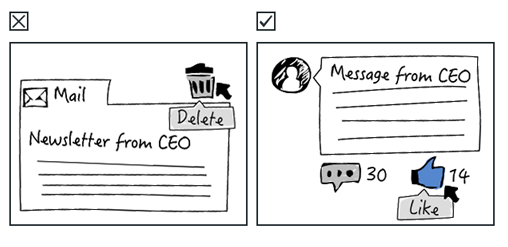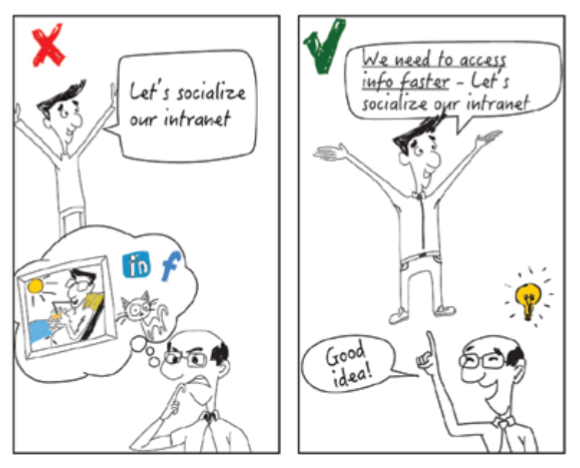Can Social Really Improve Collaboration?
Since the Enterprise 2.0 paradigm started to echo in the corporate world about a decade ago, some businesses have been experimenting with adding self-built social functionalities to their aging intranets and extranets.
Today, enterprise social networking has seen some evolution at a technological level, but the concept has essentially remained the same.
Public social media got adopted on a massive scale, so the opportunity for the business world was clear: leverage the cause and effect of social media’s success in a corporate intranet context; the cause being the effectiveness of the technology itself in connecting people with each other and with information, and the effect being the now-widely established user tech habits and behavioral patterns ready to be tapped into to become free from learning curves or lack of engagement in enterprise software.
Several software vendors thus began offering pre-built, dedicated enterprise social networking software for organizations interested in the benefits the mere implementation of such software promised.
Despite said advances and the new accessibility of this technology, numerous organizations still remained on the fence about this often-overhyped proposition, which seldom managed to address their concerns with value they could actually fit into their worldviews.
A recent study suggested that this is very much affected by the perceptual concerns of business users with regards to things like privacy and the free flow of information in so-called enterprise social networks.
Amid those that implemented enterprise social software are businesses that came to realize that implementation is by no means a sure path to automatic, wide-scale adoption by employees.
It is often the case that efforts to bootstrap adoption are still required, namely making sure employees know how to use it and making sure the social tools are implemented in a way that is actually useful to employees, that the value of these tools is made visible to them in light of their particular situations, and that adopting it is sufficiently championed from within and not from without.
In terms of the software itself, in order for it to bring said value, it needs to first have a clear purpose for being socialized.
This means that social tools and techniques must be implemented not for their own sake or for replicating the public social media experience then trying to force-feed it to business users but rather as tools for which the raison d’être is to serve digital collaboration and streamline users’ experiences around it. This is different from public social media, which exists for its own sake and emphasizes connecting and socializing as the value in itself.
Below are five areas in which digital collaboration software can exemplify this:
1. News feeds and communication threads
In the old days, the options for these were quite limited. One could publish news and announcements through either static web content on a traditional intranet site or in email lists.
When Enterprise 2.0 came along, RSS feeds to which users could subscribe were introduced. But contemporary social functionality added to certain corporate news feeds makes them even more dynamic and engaging to employees.
 These feeds could also be integrated with key productivity apps to automatically aggregate the activity taking place in them.
These feeds could also be integrated with key productivity apps to automatically aggregate the activity taking place in them.
All of this could be organized based on workspaces or projects. An employee can then just focus on working on a new awesome corporate slide deck, for instance, and not focus on the visibility of his work to his teammates nor on constantly asking for updates about their activities.
2. Integration of comments and @mentions in all key areas
These familiar-sounding features are not only useful in news feeds; they can also be embedded everywhere collaboration may be involved within a consistent, harmonized experience. You want to always be able to comment on, ask questions about, or offer suggestions on things like documents and tasks while mentioning colleagues so they can be notified.
3. Notification channels
A digital workplace can benefit greatly from a user-centric notification system that unifies all notifications from different collaborative tools and delivers them to users through appropriate channels according to their preferences.
Just like the now-dynamic federated news feeds, these notifications help save time spent dealing with things like email clutter and accelerate access to information while giving users control of the noise level.
4. User directories and profiles
User directories and profile pages can also benefit from a certain level of socialization. Profile pages that employees can enrich and keep updated with information, such as work and project experiences and skill sets, can improve findability if that information is indexed. It can also help facilitate project team building or internal hiring/evolution.
Buttons on profile pages, such as for adding the person to contacts or messaging them, can also be convenient.
5. Instantaneous communication
In our tech-centric times, instant messaging, which allows real-time collaboration, has become a powerful productivity and efficiency tool. Embedding this tool in your collaboration platform and making sure it integrates with your other collaborative apps instead of using it in isolation can only increase value.
So can social really improve collaboration? If the software in question implements social features sensibly in a way that enhances the productivity stack (or whatever the software’s core specialty may be) and makes it more useful and if the vendor can help key users understand and make the most out of this integrated experience, the answer is a resounding “Yes.”

